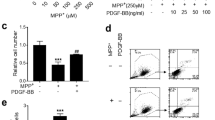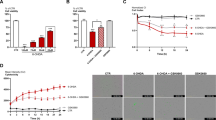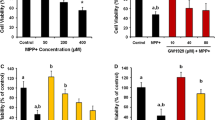Abstract
The neuroprotective action of puerarin in Parkinson’s disease (PD) models has been well investigated. However, the mechanisms involved in protection have not been completely understood. G protein-coupled receptor 30 (GPR30) is a G protein-coupled estrogen receptor and considered a potential target in the neuroprotection against PD. In this study, we investigated whether puerarin prevented against 1-methyl-4-phenylpyridinium (MPP+)-induced cell death via GPR30. Our results showed that the GPR30 agonist, G1, exhibited puerarin-mediated neuroprotection against MPP+-induced cell death of SH-SY5Y cells. This protective action was reversed by the GPR30 antagonist. Moreover, a time- and concentration-dependent effect of puerarin on GPR30 expression was verified at the protein level but not at the mRNA level. Further, we showed that an mTor-dependent new GPR30 synthesis contributed to the protection conferred by puerarin. Finally, glial cell line-derived neurotrophic factor (GDNF) levels were enhanced by puerarin and G1 in both control and MPP+-lesioned cells via GPR30. Taken together, our data strongly suggest that puerarin prevents MPP+-induced cell death via facilitating GPR30 expression and GDNF release.





Similar content being viewed by others
References
Al Sweidi S, Sanchez MG, Bourque M, Morissette M, Dluzen D, Di Paolo T (2012) Oestrogen receptors and signalling pathways: implications for neuroprotective effects of sex steroids in Parkinson’s disease. J Neuroendocrinol 24:48–61
Bessa A, Campos FL, Videira RA, Mendes-Oliveira J, Bessa-Neto D, Baltazar G (2015) GPER: a new tool to protect dopaminergic neurons? Biochim Biophys Acta 1852:2035–2041
Bourque M, Morissette M, Cote M, Soulet D, Di Paolo T (2013) Implication of GPER1 in neuroprotection in a mouse model of Parkinson’s disease. Neurobiol Aging 34:887–901
Bourque M, Morissette M, Di Paolo T (2014) Raloxifene activates G protein-coupled estrogen receptor 1/Akt signaling to protect dopamine neurons in 1-methyl-4-phenyl-1,2,3,6-tetrahydropyridine mice. Neurobiol Aging 35:2347–2356
Bourque M, Morissette M, Di Paolo T (2015) Neuroprotection in parkinsonian-treated mice via estrogen receptor alpha activation requires G protein-coupled estrogen receptor 1. Neuropharmacology 95:343–352
Briz V, Liu Y, Zhu G, Bi X, Baudry M (2015a) A novel form of synaptic plasticity in field CA3 of hippocampus requires GPER1 activation and BDNF release. J Cell Biol 210:1225–1237
Briz V, Zhu G, Wang Y, Liu Y, Avetisyan M, Bi X, Baudry M (2015b) Activity-dependent rapid local RhoA synthesis is required for hippocampal synaptic plasticity. J Neurosci 35:2269–2282
Chen SS, Yang C, Hao F, Li C, Lu T, Zhao LR, Duan WM (2014) Intrastriatal GDNF gene transfer by inducible lentivirus vectors protects dopaminergic neurons in a rat model of parkinsonism. Exp Neurol 261:87–96
Cheng Y, Zhu G, Guan Y, Liu Y, Hu Y, Li Q (2011) Protective effects of puerarin against 1-methyl-4-phenylpyridinium-induced mitochondrial apoptotic death in differentiated SH-SY5Y cells. Zhongguo Zhong Yao Za Zhi 36:1222–1226
Cheng YF, Zhu GQ, Wang M, Cheng H, Zhou A, Wang N, Fang N, Wang XC, Xiao XQ, Chen ZW, Li QL (2009) Involvement of ubiquitin proteasome system in protective mechanisms of puerarin to MPP(+)-elicited apoptosis. Neurosci Res 63:52–58
Cote M, Bourque M, Poirier AA, Aube B, Morissette M, Di Paolo T, Soulet D (2015) GPER1-mediated immunomodulation and neuroprotection in the myenteric plexus of a mouse model of Parkinson’s disease. Neurobiol Dis 82:99–113
d’Anglemont de Tassigny X, Pascual A, Lopez-Barneo J (2015) GDNF-based therapies, GDNF-producing interneurons, and trophic support of the dopaminergic nigrostriatal pathway. Implications for Parkinson’s disease Front Neuroanat 9:10
Gao J, Kang XY, Sun S, Li L, Zhang BL, Li YQ, Gao DS (2016) Transcription factor Six2 mediates the protection of GDNF on 6-OHDA lesioned dopaminergic neurons by regulating Smurf1 expression. Cell Death Dis 7:e2217
Ge X, Guo R, Qiao Y, Zhang Y, Lei J, Wang X, Li L, Hu D (2013) The G protein-coupled receptor GPR30 mediates the nontranscriptional effect of estrogen on the activation of PI3K/Akt pathway in endometrial cancer cells. Int J Gynecol Cancer 23:52–59
Jacenik D, Cygankiewicz AI, Krajewska WM (2016) The G protein-coupled estrogen receptor as a modulator of neoplastic transformation. Mol Cell Endocrinol 429:10–18
Javed H, Azimullah S, Abul Khair SB, Ojha S, Haque ME (2016) Neuroprotective effect of nerolidol against neuroinflammation and oxidative stress induced by rotenone. BMC Neurosci 17:58
Ji M, Liu Y, Yang S, Zhai D, Zhang D, Bai L, Wang Z, Yu J, Yu C, Cai Z (2013) Puerarin suppresses proliferation of endometriotic stromal cells in part via differential recruitment of nuclear receptor coregulators to estrogen receptor-alpha. J Steroid Biochem Mol Biol 138:421–426
Kells AP, Eberling J, Su X, Pivirotto P, Bringas J, Hadaczek P, Narrow WC, Bowers WJ, Federoff HJ, Forsayeth J, Bankiewicz KS (2010) Regeneration of the MPTP-lesioned dopaminergic system after convection-enhanced delivery of AAV2-GDNF. J Neurosci 30:9567–9577
Kelly MJ, O’Keeffe GW, Sullivan AM (2015) Viral vector delivery of neurotrophic factors for Parkinson’s disease therapy. Expert Rev Mol Med 17:e8
Kim J, Szinte JS, Boulware MI, Frick KM (2016) 17beta-estradiol and agonism of G-protein-coupled estrogen receptor enhance hippocampal memory via different cell-signaling mechanisms. J Neurosci 36:3309–3321
Lebesgue D, Chevaleyre V, Zukin RS, Etgen AM (2009) Estradiol rescues neurons from global ischemia-induced cell death: multiple cellular pathways of neuroprotection. Steroids 74:555–561
Lee TM, Lin SZ, Chang NC (2014) Both GPER and membrane oestrogen receptor-alpha activation protect ventricular remodelling in 17beta oestradiol-treated ovariectomized infarcted rats. J Cell Mol Med 18:2454–2465
Lu-Nguyen NB, Broadstock M, Schliesser MG, Bartholomae CC, von Kalle C, Schmidt M, Yanez-Munoz RJ (2014) Transgenic expression of human glial cell line-derived neurotrophic factor from integration-deficient lentiviral vectors is neuroprotective in a rodent model of Parkinson’s disease. Hum Gene Ther 25:631–641
Malkus KA, Tsika E, Ischiropoulos H (2009) Oxidative modifications, mitochondrial dysfunction, and impaired protein degradation in Parkinson’s disease: how neurons are lost in the Bermuda triangle. Mol Neurodegener 4:24
Ojha S, Javed H, Azimullah S, Haque ME (2016) Beta-caryophyllene, a phytocannabinoid attenuates oxidative stress, neuroinflammation, glial activation, and salvages dopaminergic neurons in a rat model of Parkinson disease. Mol Cell Biochem 418:59–70
Sun M, Xie HF, Tang Y, Lin SQ, Li JM, Sun SN, Hu XL, Huang YX, Shi W, Jian D ( 2016) G proteincoupled estrogen receptor enhances melanogenesis via cAMP-protein kinase (PKA) by upregulating microphthalmia-related transcription factor-tyrosinase in melanoma. J Steroid Biochem Mol Biol 2016 Jul 1. pii: S0960-0760(16)30195–9. doi:10.1016/j.jsbmb.2016.06.012
Surmeier DJ, Guzman JN, Sanchez-Padilla J, Goldberg JA (2010) What causes the death of dopaminergic neurons in Parkinson’s disease? Prog Brain Res 183:59–77
Tang H, Zhang Q, Yang L, Dong Y, Khan M, Yang F, Brann DW, Wang R (2014) GPR30 mediates estrogen rapid signaling and neuroprotection. Mol Cell Endocrinol 387:52–58
Tran QK, Firkins R, Giles J, Francis S, Matnishian V, Tran P, VerMeer M, Jasurda J, Burgard MA, Gebert- Oberle B (2016) Estrogen enhances linkage in the vascular endothelial calmodulin network via a feedforward mechanism at the G protein-coupled estrogen receptor 1. J Biol Chem 291(20):10805–23
Tuscher JJ, Luine V, Frankfurt M, Frick KM (2016) Estradiol-mediated spine changes in the dorsal hippocampus and medial prefrontal cortex of ovariectomized female mice depend on ERK and mTOR activation in the dorsal hippocampus. J Neurosci 36:1483–1489
Wang Y, Zhu G, Briz V, Hsu YT, Bi X, Baudry M (2014) A molecular brake controls the magnitude of long-term potentiation. Nat Commun 5:3051
Xing L, Esau C, Trudeau VL (2015) Direct regulation of aromatase B expression by 17beta-estradiol and dopamine D1 receptor agonist in adult radial glial cells. Front Neurosci 9:504
Yang WR, Zhu FW, Zhang JJ, Wang Y, Zhang JH, Lu C, Wang XZ (2016) PI3K/Akt activated by GPR30 and Src regulates 17beta-estradiol-induced cultured immature boar Sertoli cells proliferation. Reprod Sci 2016 May 24. pii: 1933719116649696. doi:10.1177/1933719116649696
Zhang Y, Chen J, Zhang C, Wu W, Liang X (2005) Analysis of the estrogenic components in kudzu root by bioassay and high performance liquid chromatography. J Steroid Biochem Mol Biol 94:375–381
Zhao Q, Ye J, Wei N, Fong C, Dong X (2016) Protection against MPP-induced neurotoxicity in SH-SY5Y cells by tormentic acid via the activation of PI3-K/Akt/GSK3beta pathway. Neurochem Int 97:117–123
Zheng G, Zhang X, Zheng J, Meng Q, Zheng D (2002) Estrogen-like effects of puerarin and total isoflavones from Pueraria lobata. Zhong Yao Cai 25:566–568
Zhu G, Wang X, Chen Y, Yang S, Cheng H, Wang N, Li Q (2010) Puerarin protects dopaminergic neurons against 6-hydroxydopamine neurotoxicity via inhibiting apoptosis and upregulating glial cell line-derived neurotrophic factor in a rat model of Parkinson’s disease. Planta Med 76:1820–1826
Zhu G, Wang X, Wu S, Li Q (2012) Involvement of activation of PI3K/Akt pathway in the protective effects of puerarin against MPP+-induced human neuroblastoma SH-SY5Y cell death. Neurochem Int 60:400–408
Zhu G, Wang X, Wu S, Li X, Li Q (2014) Neuroprotective effects of puerarin on 1-methyl-4-phenyl-1,2,3,6-tetrahydropyridine induced Parkinson’s disease model in mice. Phytother Res 28:179–186
Zou Y, Hong B, Fan L, Zhou L, Liu Y, Wu Q, Zhang X, Dong M (2013) Protective effect of puerarin against beta-amyloid-induced oxidative stress in neuronal cultures from rat hippocampus: involvement of the GSK-3beta/Nrf2 signaling pathway. Free Radic Res 47:55–63
Acknowledgments
This work was supported by Natural Science Foundation of Hebei Province, China (Grant No. H2014209300), and Research Project of Administration of Traditional Chinese Medicine of Hebei Province, China (Grant No. 2013180), to YC. This work was also supported by the National Natural Science Foundation of China (81673716, 81601181) to GZ.
Author information
Authors and Affiliations
Corresponding author
Ethics declarations
Conflict of Interest
The authors declare that they have no conflict of interest.
Additional information
Yue-Fa Cheng and Guoqi Zhu contributed equally to this work.
Rights and permissions
About this article
Cite this article
Cheng, YF., Zhu, G., Wu, QW. et al. GPR30 Activation Contributes to the Puerarin-Mediated Neuroprotection in MPP+-Induced SH-SY5Y Cell Death. J Mol Neurosci 61, 227–234 (2017). https://doi.org/10.1007/s12031-016-0856-y
Received:
Accepted:
Published:
Issue Date:
DOI: https://doi.org/10.1007/s12031-016-0856-y




